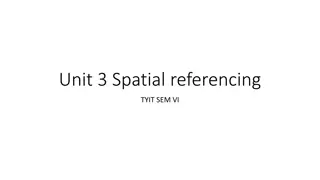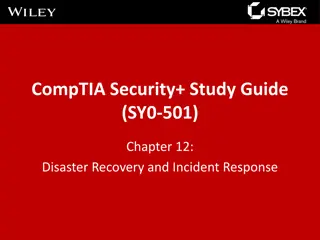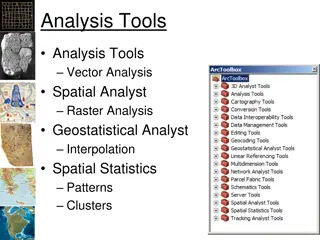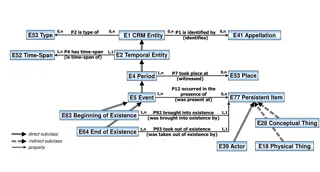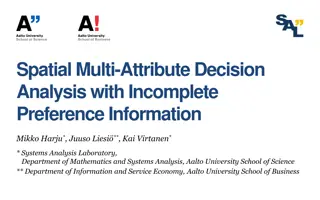Understanding Spatial Continuity in Geostatistics
Explore the concept of spatial continuity in geostatistics through descriptive analysis of sample data, variograms, covariance functions, and omnidirectional variograms. Learn about terminologies such as range, sill, and nugget effect, and the importance of omnidirectional variograms in capturing overall spatial continuity patterns.
Download Presentation

Please find below an Image/Link to download the presentation.
The content on the website is provided AS IS for your information and personal use only. It may not be sold, licensed, or shared on other websites without obtaining consent from the author. Download presentation by click this link. If you encounter any issues during the download, it is possible that the publisher has removed the file from their server.
E N D
Presentation Transcript
Geo479/579: Geostatistics Ch7. Spatial Continuity
Objective Exploratory analysis of sample data by describing spatial continuity of two continuous variables and their cross- continuity
h-Scatterplot Tolerance in Sample Very few pairs of samples are separated exactly by h, because there is inevitable randomness in the sample locations for any chosen h. In practice, tolerances are specified both on the distance of h and on its direction. Figure 7.1 shows a tolerance of 1 m on the distance and 20 degrees on the direction of h.
Some Terminologies of Variogram Variogram is the most traditional choice to summarize spatial continuity, in comparison to correlation function and covariance.
Some Terminologies of Variogram Range is the distance (h) at which the variogram reaches its plateau. Sill is the plateau that the variogram reaches at the range. Nugget effect is the vertical jump from the value of zero at the origin to the value of variogram at extremely small separation distances, due to sampling error or short scale variability.
Omnidirectional Variogram Omnidirectional means all directions. It combines all directional variograms into a single semivariogram. Omnidirectinal variogram can be loosely thought of as an average of the various directional variograms. However, the calculation of omnidirectional variogram does not imply that spatial continuity is the same in all direction.
Purpose of Omnidirectional Variogram It serves as a useful starting point for producing a clear structure of overall spatial continuity. Since the omnidirectional variogram contains more sample pairs than any directional variogram, it is more likely to show a clearly interpretable structure. It can help detect some erratic directional variograms if an omnidirectional variogram is messy.
Choosing the Distance Parameters Two distance parameters need to be chosen Lag spacing (lag increment) - Assuming the samples are regularly spaced over the study area, set the initial spacing as: sqrt (study area/total number of points) Lag tolerance = lag spacing
Choosing the Distance Parameters Distance parameters can be set differently according to directions, if the sampling pattern is noticeably anisotropic. For samples located close to each other, it is possible to include an additional lag with small separations and a small tolerance for this first lag. E.g. 0.5m, 1m, 2m, 3m
This omni-variogram has a clear structure but has a jagged appearance.
Pattern of Anisotropy After having an acceptable omnidirectional variogram, we can explore the pattern of anisotropy with various directional variograms. Isotropy vs. anisotropy. The direction of maximum spatial continuity and the direction of minimum spatial continuity.
Pattern of Anisotropy Choose a directional tolerance that is large enough to allow sufficient pairs for a clear variogram, yet small enough that the character of the variograms for separate directions is not blurred beyond recognition.
Finding the Anisotropy Axes Figure 7.4: Tolerance on h is defined in a rectangular coordinate system. Figure 7.5: Posting of a semivariogram surface. Figure 7.6: A contour map of the variogram surface.
Finding the Anisotropy Axes Figure 7.7: Nine directional sample variogram each showing the lag distance corresponding to a value of 80,000ppm2. Figure 7.8: A rose diagram of the nine ranges. Figure 7.9: An ellipse fit to the rose diagram of nine ranges. The major and minor axes of the ellipse represent the axes of a geometric anisotropy.
Choosing the Directional Tolerance After identifying directions, it is time to choose directional tolerance. Directional tolerance should be large enough to contain enough pairs and small enough to avoid blurring the anisotropy resulted from combining pairs of different directions. Try several tolerances and use the smallest one that still produces good results.
Choosing the Directional Tolerance... Figure 7.10: A directional tolerance of 40o is large enough to allow a clear directional variogram while still preserving the evident anisotropy. Figure 7.3
Sample Variograms for U Hole effect is a certain dip that occurs in a sample variogram. It happens when there is a natural cyclicity or repetition in a data set.
Sample Variograms for U Presence of outliers can result in poor behavior of a variogram. One can try removing the most erratic samples in order to retain the useful contribution of large sample values. Fig 7.13-7.15.
Sample Variograms for U There are many data sets for which the sample variogram is simply inappropriate as a descriptive tool. The variogram works well when there is no proportional effect or no obvious clusters in a data. Fluctuation in the lag means is a problem. Table 7.5.
Relative Variogram To account for varying means, relative variograms scale the original variogram to some local mean value. Local Relative Variogram General Relative Variogram Pairwise Relative Variogram
Local Relative Variogram Local relative variogram divides an area in regions and treats data in each region a separate population, Fig 7.16. A local variogram is scaled by the local mean. Then the local variograms are summed to form the overall variogram ( ) h 2 n ( ) N h i m ) i = 1 i = ( ) i h LR n ( N h i = 1 i
General Relative Variogram General relative variogram does not require small populations which may cause local variograms to be erratic. Instead, the semivariance for each h is adjusted by the mean of all the data values that are used to calculate the semivariance. ) ( ) ( h m 1 ) ( )| , ( h h j i h N ij h = h GR 2) ( + m m = + = + h h m h v v i j 2 ( ) 2
Pairwise Relative Variogram Pairwise relative variogram also adjusts the variogram calculation by a squared mean. This adjustment, however, is done separately for each pair of sample values, using the average of the two values as the local mean: 2 ( ) v v 1 h j )| i j = ( ) h PR + 2 v v 2 ( ) N h 2 ( ) i j ( , i h ij
Covariance Function and Correlogram The covariance function and correlogram are likely to be more resistant to erratic values since they account for lag means (in case of covariance) and lag variance (in case of correlogram). The relationship between covariance to variogram, between correlogram and variogram C(0) - C(h) = (h), (0) - (h) = (h)/ (0)
Directional Covariance Functions for U










